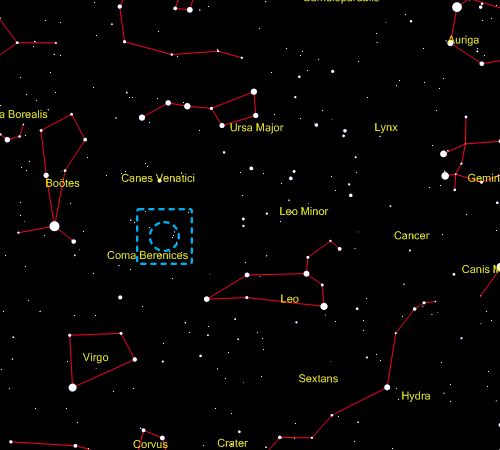At first glance this image appears to be of a stellar open cluster. However, on closer inspection it becomes obvious that while there are a handful of bright stars, the vast majority of the points of light are in fact galaxies. There are in excess of 650 catalogued galaxies in this field of view, roll your mouse over the image for a fully annotated version of the photo. This is the Coma Cluster, Abell 1656, located around 300 million light years away from Earth in the constellation of Coma Berenices. It is one of the two major clusters comprising the Coma Supercluster, the other being the Leo Cluster, Abell 1367. The Coma Supercluster was one of the first superclusters to be discovered and has helped astronomers understand the scale structure of the Universe.
The Coma Cluster is home to many thousands of galaxies, one of the densest galaxy clusters known, yet most are not visible with an amateur telescope. This excludes the two central galaxies, NGC 2874 (left) and NGC 2889 (right), which are the two brightest members with apparent magnitudes of under 13. They both have a diameter larger than 250,000 light years and are much more massive than any galaxies in the Virgo Supercluster. Just below these two galaxies is a very obvious foreground star, HD112887, an eighth magnitude star about 260 light years away - less than one millionth of the distance to the Coma Cluster. NGC 2874 and NGC 2889 are both elliptical galaxies, which are very common in this cluster, along with lenticular galaxies, because of its high density. A high density increases the number and rate of galaxy mergers, which is believed to be the reason for the formation of elliptical and lenticular galaxies.
The Coma Cluster has played an extremely important role in the research of dark matter. In 1933, Fritz Zwicky discovered evidence for the existence of dark matter by deriving an estimate for the mass of the cluster using its gravitational pull. His estimate seemed to be much greater than what could be accounted for by the visible matter, so he then inferred that some invisible matter must have provided the extra mass. He called it Dunkle Materie in German, the first formal inference of dark matter’s existence. About 90% of the mass of the Coma Cluster (about 1.4 x 1045kg) is believed to be in the form of dark matter. Zwicky's ideas were not generally accepted for another fifty years. Today, the imprint of dark matter has been found throughout the universe, and is at least five times more prevalent than the more familiar visible matter, such as the stars and galaxies we can see. The cluster is the subject of much continuing scientific research because of its vast number of galaxies, its powerful X-ray source and its position. The cluster is situated very close to the north galactic pole in the sky, so it is far from the plane of the Milky Way making it easier to study. |


